It was with a heavy heart that the global fine wine trade learned of the passing of Barolo legend, Giuseppe Rinaldi, last week. Known for their elegant style and lengthy ageing potential, Rinaldi’s Barolos are not only some of the best that the region has to offer, but also some of the priciest.
In ‘Beppe’ Rinaldi’s honour, Wine Lister looks this week at the top five most expensive wines in Barolo. And there is good reason for these Barolos to be so pricey, with all of the five achieving a Quality score that falls into the “strongest” category on Wine Lister’s 1,000 point scale. On top of this, the first three qualify as Buzz Brands – Wine Lister’s group of wines that combine outstanding restaurant presence with online popularity.
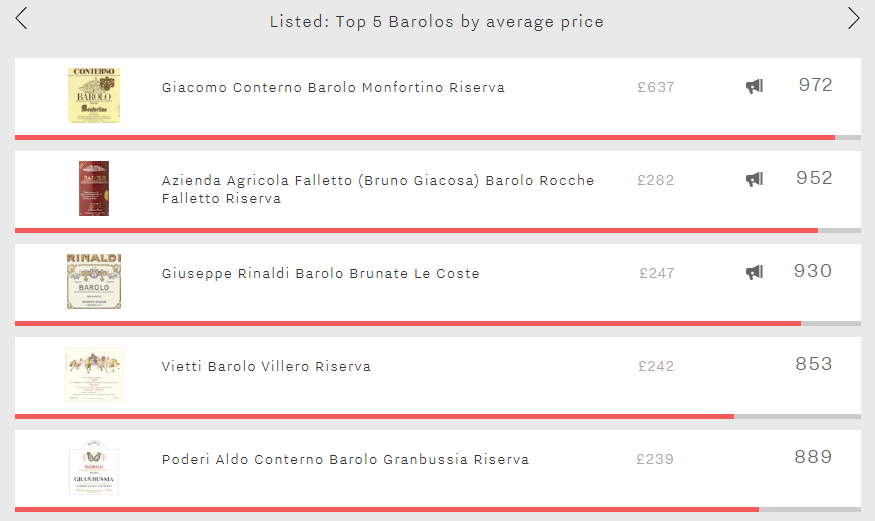
Giacomo Conterno’s Barolo Monfortino Riserva takes first place. At £637 per bottle it is more than twice the price of the rest of this week’s top five. In fact, it is the most expensive Italian wine on Wine Lister. However, it is no coincidence that Conterno’s Monfortino takes first place as it also achieves the group’s best Quality and Brand scores (977 and 969 respectively). Conterno Monfortino is actually the number one Italian wine and 11th best of all wines on Wine Lister, with an impressive overall score of 972.
This week’s second spot is occupied by Azienda Agricola Falletto (Bruno Giacosa) Barolo Rocche Falletto. Even though it competes well with Conterno Monfortino – with Quality and Brand scores of 974 and 914 respectively – it is a considerably cheaper option at £282 per bottle. In fact, despite its lower price, its Economics score is slightly superior to this week’s overall number one wine (969 vs 967), and is the group’s best. Furthermore, it is the second best of all Italian wines on Wine Lister – only beaten by Falletto’s Barbaresco Asili Riserva. The phenomenal Economics score is partly due to a three-year compound annual growth rate (CAGR) of 21.8%.
Giuseppe Rinaldi Barolo Brunate Le Coste takes third place at £247 per bottle. As perfect evidence of Rinaldi’s prowess, it is very consistent across each of Wine Lister’s three rating categories, with each score putting it amongst the very best wines in the world. Confirming its upward trajectory, it records a remarkable three-year CAGR of 36.7% – if it manages to keep that up, it will soon start to narrow the gap to Conterno’s Monfortino in this battle of the Barolos.
The two remaining wines in this group are not only very close in price but they also have the same Quality score (928). This week’s number four – at £242 per bottle – is Vietti Barolo Villero Riserva, followed closely by Poderi Aldo Conterno Barolo Granbussia Riserva at £239. Visible in 17% of the world’s top restaurants, Aldo Conterno’s Granbussia has the second-highest restaurant presence of the group. It is only beaten by this week’s number one, Conterno’s Monfortino, which is visible in 23% of top establishments.
As part of our Brand score, Wine Lister measures popularity using the three-month rolling average searches on the world’s most visited wine site, Wine-Searcher.
We have recently updated our treatment of this data to provide relative results for all 4,000+ wines on Wine Lister. Expressing each wine’s search frequency as a ranking will make it easier for our users to interpret the data. For example, Mouton is the #1 most searched-for wine of all wines on Wine Lister, according to monthly searches on Wine-Searcher.
To mark this transition, here we examine the top 50 most popular fine wines in the world.
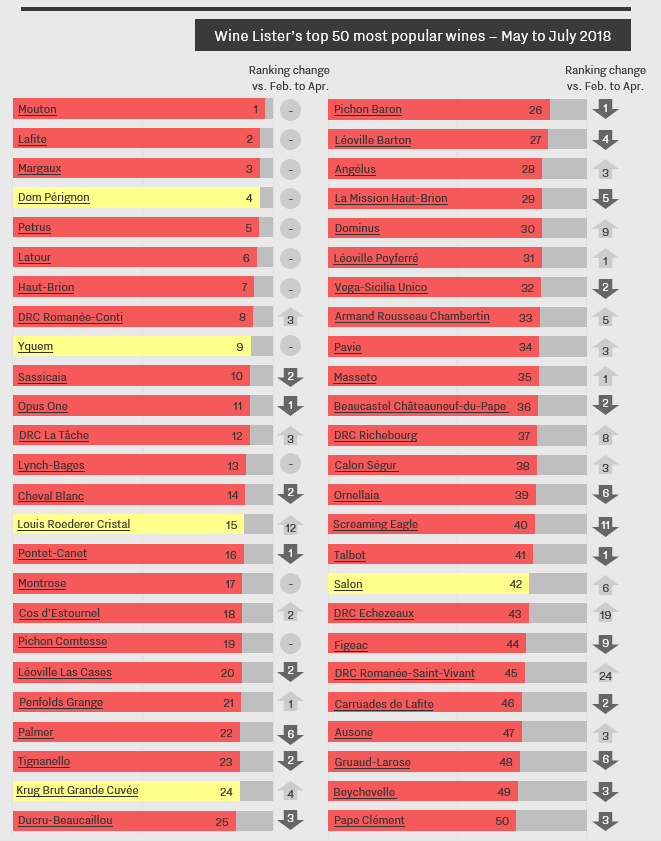
The first seven most searched-for wines for the period of May, June, and July include the five Bordeaux left bank first growths (Mouton, Lafite, Margaux, Latour, and Haut-Brion), right-bank powerhouse, Petrus, and Champagne super-brand, Dom Pérignon. It is perhaps of no surprise that these rankings remain unchanged since the previous period (February to April) .
Burgundian searches in the top 50 are dominated by Domaine de la Romanée-Conti, with Romanée-Conti, La Tâche, Echezeaux, and Romanée-Saint-Vivant all achieving better rankings versus the previous period. These four together achieve an average ranking of 30th place, and an average movement up the search ranking of 11 places.
Other than Dom Pérignon, the two remaining Champagnes featured in the top 50 most searched-for wines have moved up the rankings for May-July 2018 compared to the previous three-month period. Louis Roederer’s Cristal was up 12 places, presumably due to the release of its 2008 vintage in June. Krug’s most recent Grande Cuvée (166th edition) was released in late May, explaining its jump four spots up the rankings into 24th place.
More than half of the top 50 most popular wines are Bordeaux, with 30 wines hailing from the region. However, Bordeaux did not see the boost to their search ranking one might have expected during Bordeaux’s en primeur 2017, with one fewer of the region’s wines featuring in the top 50 than before the campaign kicked off. In fact, supporting Wine Lister’s analysis of this year’s lacklustre campaign, searches for many top Bordeaux châteaux actually fell during this period. For instance, Figeac, despite achieving Bordeaux’s 10th best Quality score of the 2017 vintage, slipped nine spots down the rankings.
Château Latour has released a parcel of Les Forts de Latour 2009 this morning at €195 per bottle ex-négociant, which will likely result in a UK release price of c.£200. Our factsheet below summarises all the key points.
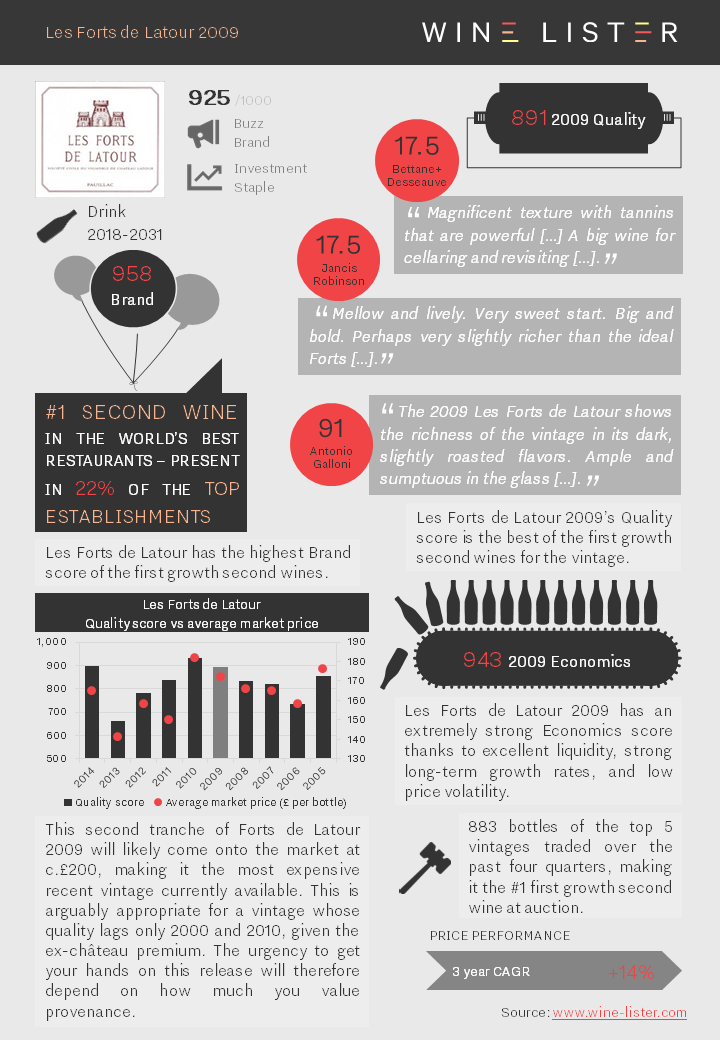
You can download the slide here: Wine Lister Factsheet Les Forts de Latour 2009
As the Place de Bordeaux reawakens for September releases this week, Wine Lister examines some “place-distributed” wines from closer to home, namely the top five Bordeaux third growths by Wine Lister score. The successful 2009 and 2010 vintages in Bordeaux helped to coin the term “super seconds”, and despite a trickier en primeur campaign this year, these five wines make a good case for a new term: “thrilling thirds”.
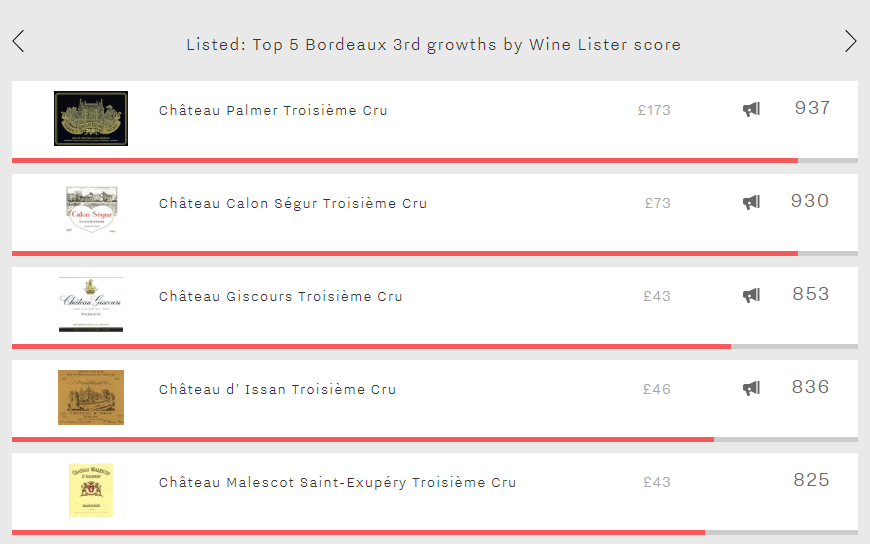
In first place, and one of the first out of the blocks for en primeur this year, is Palmer. With an overall score of 937, it is not only the best of this week’s top five, but also sits 69 points ahead of the average Bordeaux second growth Wine Lister score. Aside from its impressive Quality score (909), Palmer’s strength lies in its Brand, with a score of 995, thanks to presence in 47% of the world’s best restaurants, and being ranked 22nd out of all wines on Wine Lister for searches on Wine-Searcher.
Calon Ségur comes in second place, with an overall score of 930. It is the only Saint-Estèphe with third growth status, and the only one of this week’s top five not from Margaux (unsurprising, given that 73% of all Bordeaux left bank third growths hail from the appellation). Calon’s Economics score of 941 is the fifth-best of all Bordeaux left bank reds (beaten only by Carruades de Lafite, Château Margaux, Lafite, and Mouton). This is achieved through a three-year compound annual growth rate of 17% and short-term price performance of 8% – both the highest of this week’s top five.
Giscours is next with an overall score of 853. While Brand is its strongest score category (956), its Quality and Economics scores (804 and 782 respectively) still sit within the “very strong” section of the Wine Lister 1000-point scale. Furthermore, alongside Lynch Bages, Giscours was voted the most consistent seller (in volume terms) by the Place de Bordeaux in our 2018 Bordeaux Market Study.
The last two places of this week’s top five are taken by d’Issan in fourth place, and Malescot Saint-Exupéry at number five with scores of 836 and 825 respectively. The latter is the only one of this week’s top five that is not a Wine Lister Buzz Brand. As the least-known of the five, it might be considered the best value, with a Quality score of 811 and an average price of £43.
Analysis of Beaucastel Hommage à Jacques Perrin 2016, which has been released this morning at €270 ex-négociant (up 15% on the 2015), and is being offered in the UK at £277 (up 12% on 2015), with a higher Quality score: 988 (vs 974).
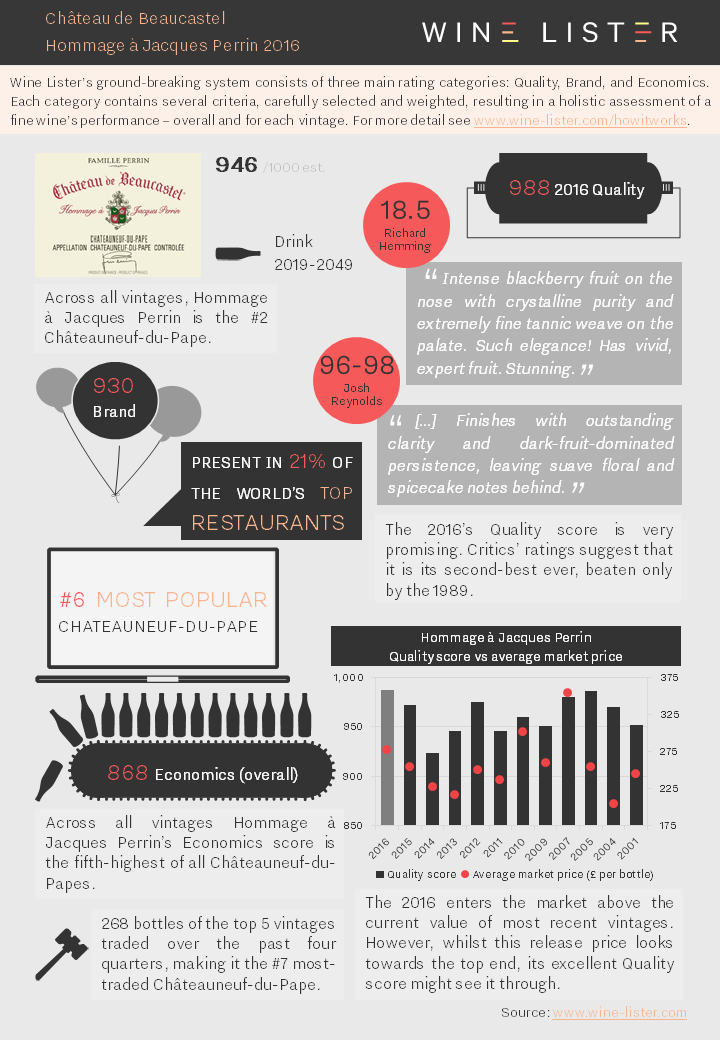
You can download the slide here: Wine Lister Factsheet Hommage a Jacques Perrin 2016
Analysis of Opus One 2015, which has been released this morning at €208 ex-négociant (up 9% on the 2014), with a UK release price of £225 (up 7% on 2014), and a higher Quality score: 978 (vs 944).
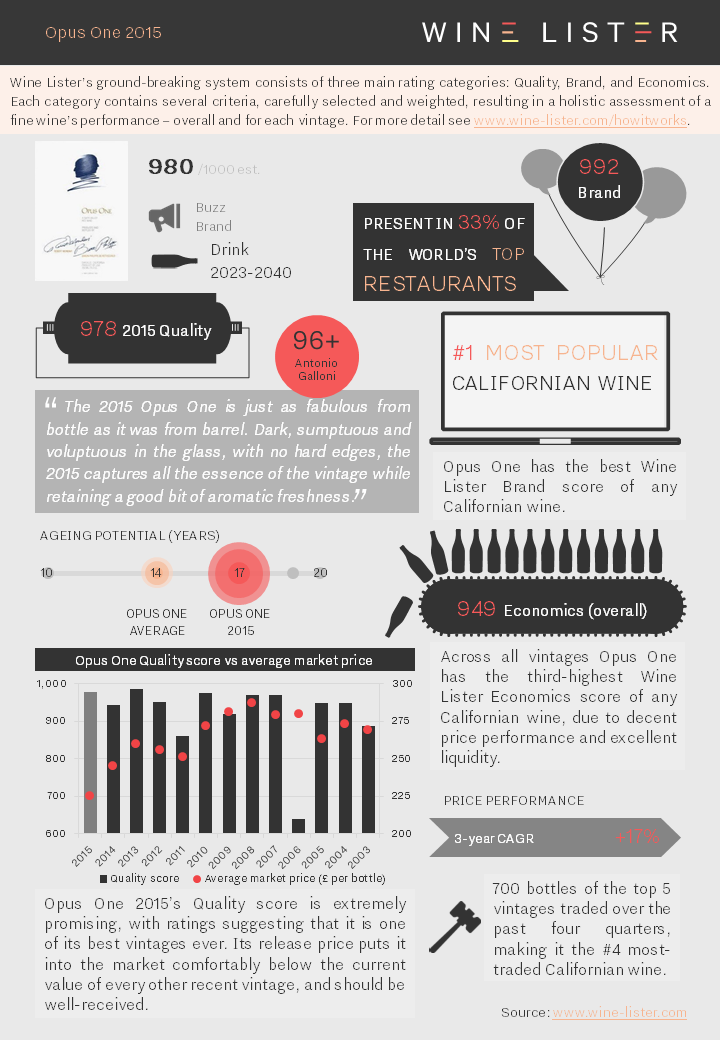
You can download the slide here: Wine Lister Factsheet Opus One 2015
This week’s top five require absolutely no introduction. As Buzz Brands – Wine Lister’s group of wines that achieve outstanding online popularity and restaurant presence, and are also identified by the global fine wine trade as trending or especially prestigious – that is perhaps a given. Couple that with the fact that they hail from Bordeaux, and are the region’s most expensive Buzz Brands, it would be nigh on impossible for you not to be familiar with them to some degree.
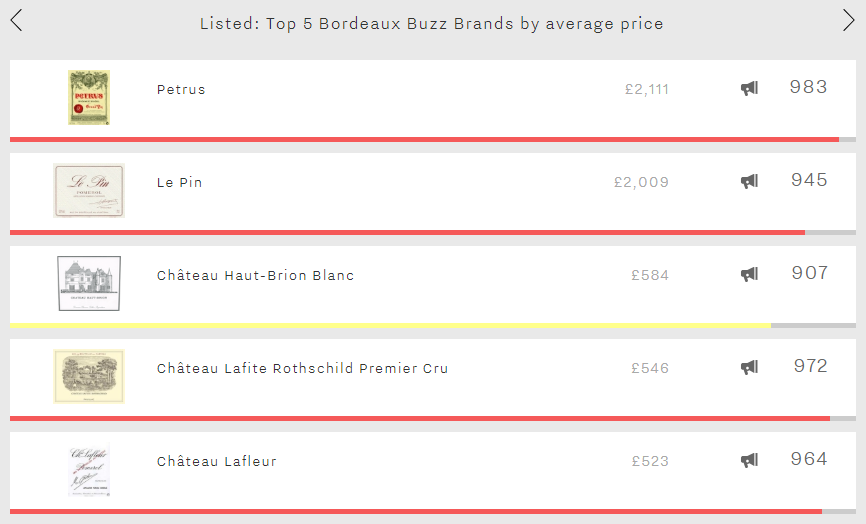
Pomerol is home to three of the five. With the limited production volumes of the plateau’s top wines, it is perhaps no surprise that they reach eye-watering prices. Petrus leads the way with an average price across all vintages of £2,111. It is Bordeaux’s best wine, and the fifth best in the world, its phenomenal score of 983 only bettered by Salon and three (!) DRC cuvées. Petrus is consistently brilliant across Wine Lister’s three rating categories with Quality, Brand, and Economics scores of 978, 998, and 972 respectively. It is worth focusing on its Brand score. Despite its relatively low production volumes, its rate of restaurant presence is outstanding. Visible in 45% of the world’s top establishments, and with more than five vintages / formats featuring on each wine list on average, it is clearly a wine that commands the utmost respect from sommeliers. Moreover, receiving over 60,000 online searches each month, it is well over five times as popular as its Pomerol neighbours Le Pin and Lafleur.
Le Pin comes next (£2,009). It enjoys Bordeaux’s second-best Economics score (979), pipped at the post by Carruades de Lafite (980). Its outstanding score comes courtesy not just of its high price, but also strong price performance, with a three-year compound annual growth rate (CAGR) of 17% and having added 8% to its price over the past six months alone. With those sorts of figures, it will soon overtake Petrus as Bordeaux’s most expensive wine – its neighbour having recorded a three-year CAGR of 13% but only managing to add 4% to its value since March.
At roughly a quarter of the price of Petrus and Le Pin, Lafleur is Bordeaux’s fifth most expensive Buzz Brand (£523). It was Bordeaux 2017’s top red for Quality, its score of 978 putting it just ahead of Petrus (971). Across all vintages it is also the longest-lived of this week’s top five, with Wine Lister’s partner critics predicting an average ageing potential of 21 years.
We cross over to the left bank for the group’s remaining two wines, the first of which might come as a slight surprise. Haut-Brion Blanc is Bordeaux’s third-most expensive Buzz Brand (£584). It is of course its rarity that propels it up the price tables. Producing just 6,720 bottles on average each year – 15 times fewer than Haut-Brion Rouge – it is over 60% more expensive than its red counterpart, despite trailing across each category.
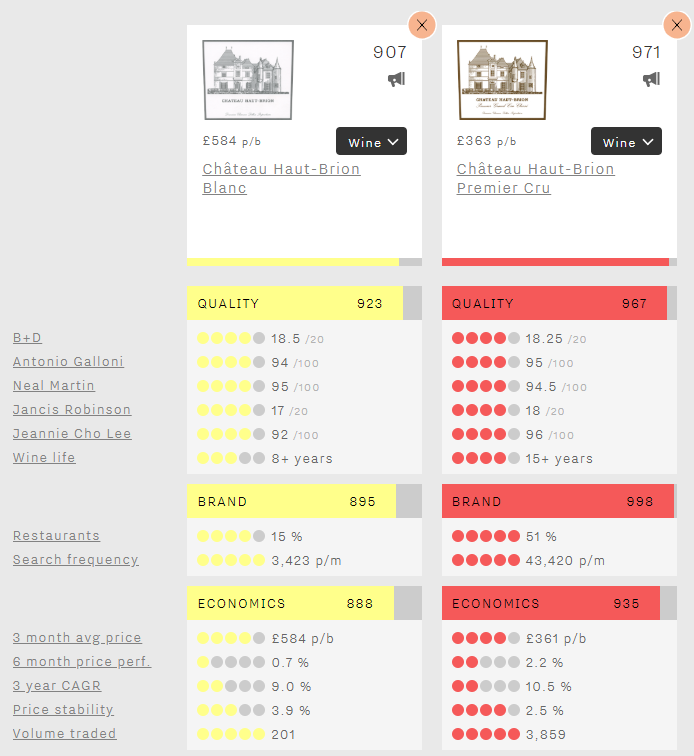
Rounding out the group – if it can ever be described as such – is Lafite (£546). With the best part of 200,000 bottles of it produced each year, it will come as no shock that it manages the best restaurant presence of the five, both in terms of the number of establishments in which it appears (54%) and the number of references per list (6.3 on average). It is also the most popular wine in the world, receiving over 80,000 online searches each month.
While wines made in The Golden State are not as affected by vintage variation as their European counterparts, the 2013 vintage was for California as close to perfect as they come. The long, hot summer led to Cabernet Sauvignons with extreme fruit concentration and firm structure – a recipe for long-term cellaring. The vintage’s economic credentials seem equally promising, with Economics scores of the top five Californian reds from the 2013 vintage outperforming their respective wine-level average by 114 points (averaging 979 in 2013 versus 864 across all vintages).
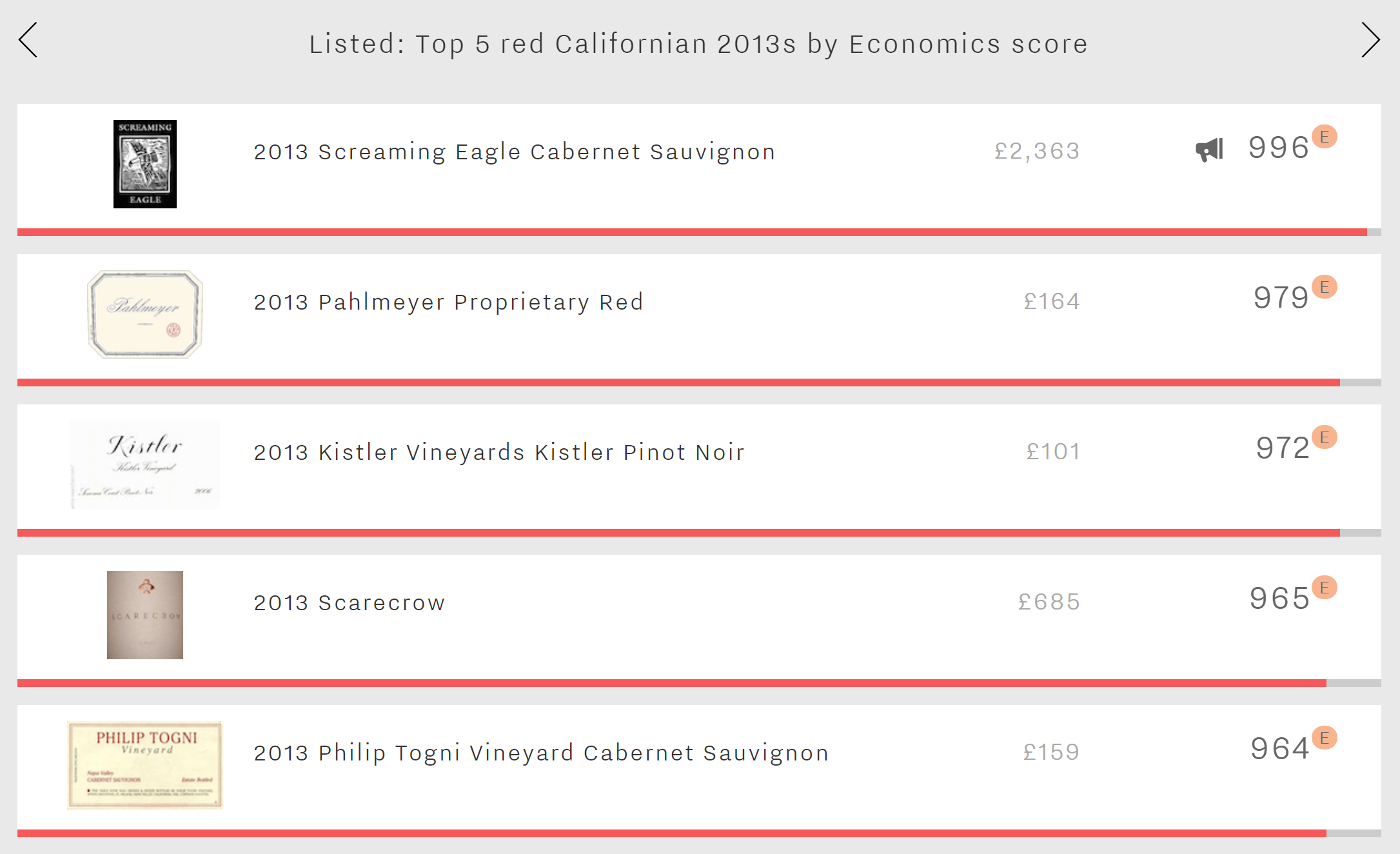
Perhaps unsurprisingly, the number one spot is taken by Screaming Eagle Cabernet Sauvignon. At 996, its Economics score is not only the highest of this week’s top five, but of all 2013s on Wine Lister (matched only by 2013 DRC Richebourg). It is also by far the most expensive of the five at £2,363 per bottle – over twice as high as the price of the other four combined. Screaming Eagle’s “mailing list” sales model teamed with tiny production quantities (7,800 bottles per annum on average) means that demand for this wine consistently outweighs supply. This could explain the wine’s strong presence on the secondary market, with 855 bottles traded at auction over the last 12 months (according to figures collated by the Wine Market Journal).
In second place is 2013 Pahlmeyer Proprietary Red. Interestingly, it has the lowest Quality score of the group. Indeed, its 2013 Quality score is 74 points lower than Pahlmeyer’s average (848). Contrastingly, the 2013 vintage receives its best ever Economics score of 979, boosted by a six-month price performance of 18.7%.
The third spot of this week’s top five is occupied by the only Pinot Noir of the group, Kistler Vineyards Pinot Noir, with an Economics score of 972. It is the only wine of the five to have been released before 2016, and thus the only one with a three-year compound annual growth rate (28.2%), whereas Economics scores for the other four 2013s are based upon price performance over the short term only. Kistler’s place in the top five 2013 Californian reds by Economics score is impressive, given its lower price point (£101 per bottle, compared with an £843 average for the other four wines).
The penultimate wine of this week’s top five is 2013 Scarecrow. Alongside its best ever Quality score (987), the 2013 vintage achieves an Economics score of 965, helped by the second-highest three-month average price (£663) and the best price stability of the group (with standard deviation of just 4.1% over the last 12 months).
Last but by no means least is Philip Togni Vineyard Cabernet Sauvignon, with an Economics score of 964. Though fifth for economics, it is number one for Quality, thanks to a 100-point score from Wine Lister partner critic, Antonio Galloni, who calls it “a majestic, towering wine… one of the wines of the vintage”.
A glass of cold Riesling on a hot summer’s day hits that sweet spot between refreshment, satisfaction, and intrigue. Any one of Germany’s finest wines for Quality under £300 would definitely deliver those three things. Moreover, with an average drinking window of 16 years, and with global warming seemingly set to deliver increasingly high summer temperatures, stock up on them now and you will be rewarded with stunning wines for years to come.

It is perhaps revealing of Riesling’s under-the-radar nature that three of this week’s top five qualify as Hidden Gems, meaning that they combine excellent critics’ ratings with modest restaurant presence and online popularity. Moreover, many of Wine Lister’s Hidden Gems were picked out by the global fine wine trade in our Founding Members’ survey, underlining the perennial mystery of Riesling as the darling of the trade, despite struggling to spark wide-scale consumer demand. Interestingly the group’s three Hidden Gems are all Beerenausleses (BAs). Schloss Johannisberg Rosa-Goldlack, Fritz Haag Brauneberger Juffer Sonnenuhr, and Weingut Robert Weil Kiedricher Gräfenberg’s BAs, in spite of a phenomenal average Quality score of 969, achieve an average Brand score of just 398 – the result of being present in just 2% of the world’s top restaurants and receiving only 70 online searches each month on average. Demand for excellent sweet Riesling is clearly not there at present.
However, returning to the group’s fantastic quality, it is Egon Müller’s Scharzhofberger Riesling Auslese that comes out on top with a score of 974. 2014 was its best ever vintage, with one of JancisRobinson.com’s critics, Michael Schmidt, awarding it 19/20 and heaping on the praise: “Our sensory perception is treated to an animating exuberance of exotic fruit and fresh raisins. Botrytis has been kept in check to focus on purity of expression rather than indulge in unctuous combustion”.
The group’s final spot is filled by Keller Westhofen Abtserde Riesling Grosses Gewächs (966). It is Jancis Robinson’s favourite of the five, achieving an outstanding average rating of 18.5/20 from Wine Lister’s UK partner critic. Tellingly, particularly in the context of the three BA’s lack of consumer demand, it is also the group’s most popular wine, receiving nearly 30 times more searches each month on average than the BAs. Consumers appear much more at ease with Riesling’s dryer styles.
Buzz Brands are wines that are sure to turn heads, destined to cause a stir whenever they are opened. They combine excellence across Wine Lister’s two Brand criteria – restaurant presence and online popularity – whilst also being held in the highest regard by the fine wine trade – as confirmed by Wine Lister’s Founding Members’ survey which gathers the opinions of around 50 key players in the international wine trade. This week, the Listed section focuses on Italy’s top five Buzz Brands by overall Wine Lister score.
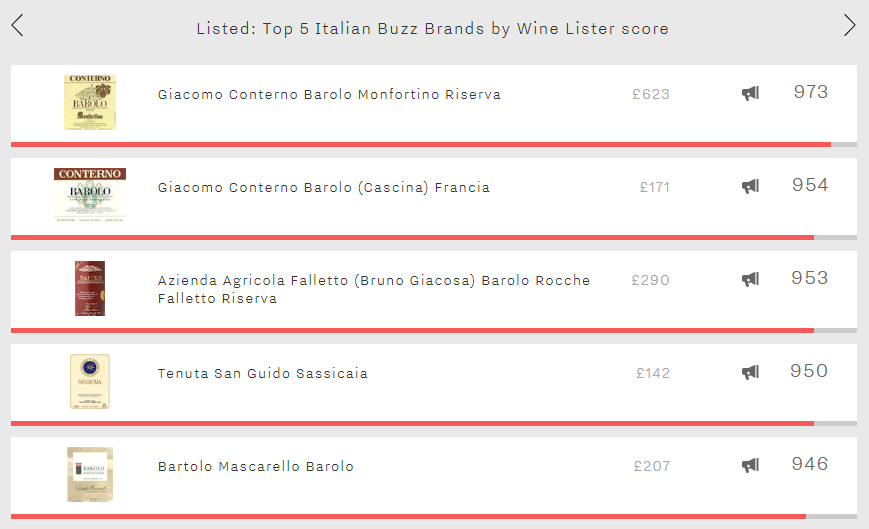
Barolo is home to four of Italy’s top five Buzz Brands, two of which are produced by Giacomo Conterno – the flagship Monfortino in first place (973) and Francia not far behind in second place (954). The Monfortino achieves Italy’s best Quality score (977), the result of remarkable consistency from vintage to vintage, having achieved a score of 993 or above in seven of the past 10 vintages. Its best ever vintage was 2004 (998), thanks to a perfect 100-point score from Antonio Galloni, who writes: “I imagine the 2004 Monfortino will give readers an utterly spellbinding drinking experience for the next few decades”.
Whilst the Francia is pipped at the post in each category by its illustrious stablemate (trailing by 17 points in the Quality category, 11 in the Brand category, and 34 in terms of Economics), it does manage superior restaurant presence, visible in 30% of the world’s top establishments, compared to the Monfortino’s 23%. This is presumably due to over three times as many bottles of it being produced each year on average.
In third place is Azienda Agricola Falletto’s Rocche Falletto Riserva (953). It records the best Economics score of the five (969) and Italy’s second-best, beaten only by Falletto’s Barbaresco Asili Riserva (978). It does so thanks to the combination of very strong growth rates – it has recorded a three-year compound annual growth rate of 21% and has added 8% to its value over the past six months alone – and strong liquidity – its top five vintages having traded 398 bottles at auction over the past year. Perhaps collectors have been eager to get their hands on a bottle after the passing of Bruno Giacosa in January.
Proving that Super Tuscans can mix it with Piedmont’s top nebbiolos, Sassicaia takes fourth place. Whilst it cannot keep pace with Barolo’s finest in the Quality and Economics categories, Sassicaia stretches out a comfortable lead in the Brand category thanks to an extraordinary score of 998. This near-perfect score puts it alongside Haut-Brion, Margaux, and Petrus, beaten only by the Pauillac First Growths, Dom Pérignon Vintage Brut, and Yquem. Its brand dominance is the result of outstanding restaurant presence (49%) and online popularity – receiving well over three times as many searches each month as Conterno’s Monfortino, which is the group’s second-most popular wine.
Rounding out the five is Bartolo Mascarello’s Barolo. Its brand is its strongest asset, its score of 964 making it Barolo’s second-strongest brand behind Conterno’s Monfortino. Despite receiving over 20% fewer online searches each month than the Monfortino, it matches its level of restaurant presence – perhaps the azienda’s famous “no barrique no Berlusconi” message strikes a chord with sommeliers.










